 Facebook
Facebook
 X
X
 Instagram
Instagram
 TikTok
TikTok
 Youtube
Youtube
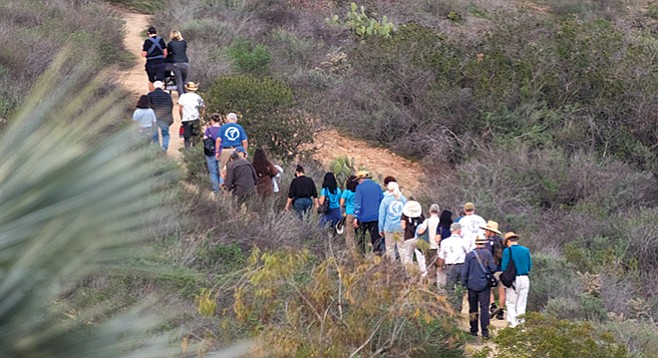
Since Afoot and Afield in San Diego County first appeared in 1986, Jerry Schad’s comprehensive guide to local hiking trails has been considered the definitive resource. But Schad’s death from liver cancer in 2011 sent the venerable hiking guide into limbo. Although a fifth edition prepared by local hiking enthusiast Scott Turner finally is scheduled for publication in February, it now faces serious competition. Coast to Cactus: The Canyoneer Trail Guide to San Diego Outdoors, released in September, 2016, is almost 600 pages long and weighs more than two and a half pounds. It contains descriptions of 245 outings (and 73 optional extension hikes) prepared by one of the best-respected hiking organizations in the county. Will it reign instead as the local hiking Bible?
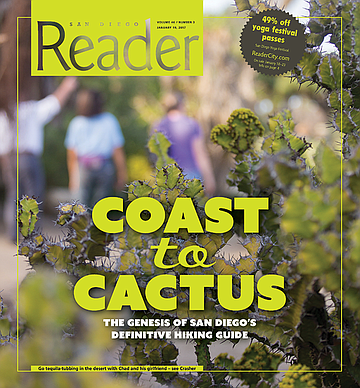
Diana Lindsay is not the most objective observer, but I asked her if the two books are competitors. Along with her husband Lowell, Lindsay cofounded the company that published Coast to Cactus. She served as the book’s managing editor and was one of its key champions. She downplays any overt competition with Schad’s work, instead arguing that the two books have different missions.
They also developed differently, though both have deep local roots. The Lindsays met as Bruin Mountaineers back in the early 1960s, when she was a UCLA freshman and he was a senior and president of the campus hiking club. “We went spelunking together at Church Cave in the Sequoias,” Diana recalls. When Lowell was accepted for Navy flight school in the fall of 1964, they impulsively eloped. “We’ve been hiking forever. It’s in our blood.”
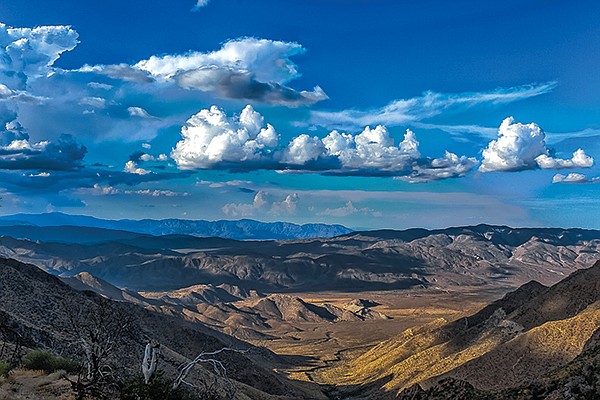
After flight school, her husband was assigned to duty as a helicopter pilot based in San Diego. Diana finished her undergraduate degree at San Diego State, and in their spare time, the couple began exploring the Anza-Borrego desert, glimpses of which had intrigued Lowell during his training flights out to Yuma. Diana also began using the desert as a topic for term papers; by the time she graduated, she’d written enough of them that a professor suggested she could easily combine them into a master’s thesis. She eventually did that, and a turn of good fortune brought her work to a larger audience. One of the professors on her thesis committee, Abraham Nasatir, was an authority on Southwest history and good friends with Richard Pourade, the editor of Copley Books. The publishing arm of the local newspaper had just released a history about Anza the explorer and wanted to publish something about the park named after him. Nasatir told Pourade about Lindsay’s work, “and the next thing, in the mail comes a contract offering to publish my master thesis,” she recalls.
Although the Lindsays left San Diego when Lowell took a job with the YMCA in Orange County, Diana says the two of them continued to hike in the Anza-Borrego desert, all the while taking notes and recording the mileage they covered. A guidebook for the desert existed but it had not been revised in years, and its elderly author was ill. Diana says she urged the park rangers to write a new one, but they weren’t interested. So she and Lowell finally decided to create one on their own. Their Anza Borrego Desert Region was published in 1978 by the Wilderness Press, but when the Lindsays moved back to San Diego in 1980, Diana wasn’t happy with the way either of her books was being marketed. That dissatisfaction led to her getting jobs in publishing and finally launching Sunbelt Publications in 1984.

Diana says it was sometime after she and Lowell wrote their desert guidebook that they first met Schad in a writing group. A shy young astronomer with a pronounced stutter and a passion for the natural world, he had a vision for creating a county-wide guide to the varied hiking opportunities here. He got a start on the research while writing a series of articles for San Diego Home/Garden magazine, and later, the San Diego edition of the Los Angeles Times. Wilderness Press wound up publishing the first collection of his outing descriptions in 1986. In 1992, Schad started a new column, “Roam-O-Rama,” which began appearing weekly in the San Diego Reader and provided material for his later editions of the hiking handbook.
Diana Lindsay says over the years she expressed interest in Sunbelt’s acquiring Schad’s Afoot and Afield from Wilderness Press, but the other publisher never wanted to relinquish it. (She never succeeded at getting the publishing rights to her own Anza Borrego Desert Region back from Wilderness, which will soon be issuing a sixth edition of it.) Sunbelt did release a guide to cycling in San Diego written by Schad. But by 2001, Lindsay had developed a vision for a different kind of book to accompany locals hitting the trails.
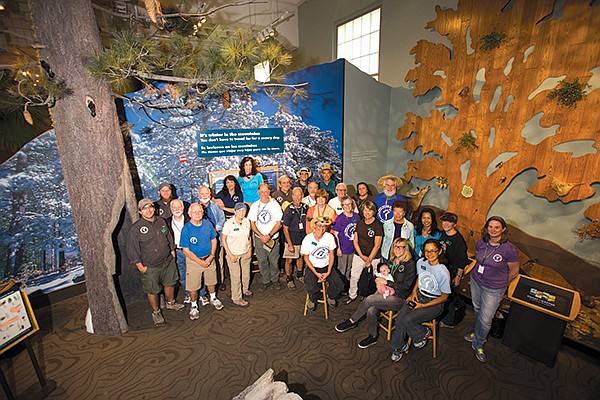
She says it was inspired by what she’d learned in the Canyoneers group at the San Diego Natural History Museum. That group had been started back in the 1970s by a museum botanist named Helen Chamlee, who wanted to introduce more members of the general public to hiking. Chamlee designed classes to train volunteers to lead nature walks in Florida Canyon, just east of the museum. “You had to take an eight-week course and then lead public hikes for two years,” Diana says. She and Lowell had grown increasingly curious about and interested in the plants, animals, and geology of the areas they were exploring in the desert, so around 1988, they took the classes and joined the cadre of Canyoneer volunteers. By then the group had expanded beyond Florida Canyon and was offering hikes countywide. Diana says she and Lowell suggested a number of desert destinations for inclusion in the regular outings.
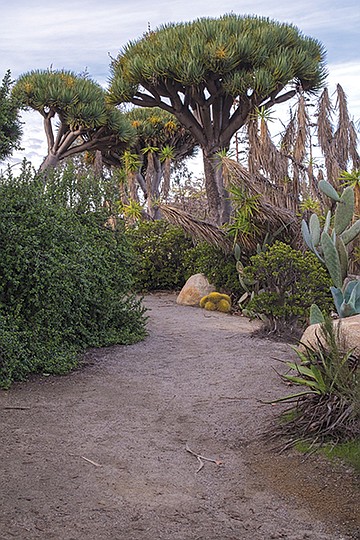
The two of them were troubled, however, by the fact that inquisitive hikers had to take along so many books — trail guides, bird guides, plant guides, mineral references — in order to understand what they were seeing. “We kept saying, ‘Wouldn’t it be great to have one book that combined everything?’” The Canyoneers for years had been keeping notes about the natural features of all the hikes led by its volunteers. Diana says in 2001 she finally suggested to two Canyoneer leaders, Alan Marshall and Paula Knoll, that the organization should create its own combination trail-and-field guide, using all the material amassed over the years. Marshall and Knoll were enthusiastic. But when the trio went before the whole organization in early January 2002, the idea “went over like a lead balloon.” The other members thought it was overwhelming, Diana says. “They were all volunteers, and it was too massive a job.”
In the years that followed, Lindsay and Marshall periodically tried to resuscitate the idea. “But it never got anywhere,” Diana says.
Then Schad died. His passage rocked all those who knew him or were fans of his writing. His discovery in 2010 that he had end-stage kidney cancer was made even crueler by the fact that he had just met Peg Reiter, who appeared to be his soul mate. The two married, but they had all too little time together before Schad succumbed to his illness at 61.
On October 4, 2011, a group gathered at the patio of the El Cortez Hotel for a memorial service. Diana was among them. She says before Schad died he had talked to a longtime friend, Don Endicott, about taking over revisions of Afoot and Afield, and Wilderness Press wanted Endicott to do it. But the size of the task daunted Endicott. Diana says, at the service, San Diego Reader publisher Jim Holman “stood up and said some very nice things about Jerry. Then he mentioned that they had enough columns to get through to the end of the year, but they needed someone to take it over. He said if anyone was interested, they should call.”
Diana felt electrified by the opportunity. She, Marshall, and Knoll once again presented the idea of a Canyoneer-created hiking-and-field guide, but with a new twist: the task of writing the entries could be spread over the group’s more than 60 members, over years, if necessary, with each member signing up for one column at a time and taking months to write his or her column, if necessary. “All along, the intent was to get enough of these columns to put a book together,” Diana says. With the column format providing structure and motivation, the task suddenly seemed manageable.
Another part of Diana’s pitch was that all the royalties from the book would go to the museum to help support its activities. The Canyoneers traditionally had raised a couple of thousand dollars each year by collecting and selling mistletoe during the holiday season, but a big new book could significantly boost that contribution, her argument went. Persuaded by it, the Canyoneers and the museum signed a memorandum of understanding with Sunbelt.
The first Canyoneer-written “Roam-O-Rama” column appeared in January 2012. “We started by taking all the Canyoneer hikes that we had already done and asking people to sign up to write about them.” At that point, the group had developed probably 75 to 100 outings throughout the county, Diana estimates. She says, “We also looked at Jerry’s book to see what he had done. It was old [2007] and hadn’t been revised as fires had occurred. So we had to see if the hikes in his book were still good or bad. Also, the county and the people at California State Parks had developed new hikes.” The Canyoneers sought input from them and other organizations. “Any of their suggestions that were not already Canyoneer hikes were put on our list, and then we asked Canyoneers to go out and scope them out.”
“We ended up finding a lot of hikes that Jerry didn’t have,” Diana says. “And there were hikes that he had but we didn’t include because times had changed; there were fires, or the rules and regulations had changed, or something. Also, we decided not to include most of his hikes that were outside the county.”
Even so, by 2015, 260 hikes had been written up by Canyoneers and edited by Diana, Knoll, and a Canyoneer named Terri Varnell. (Sadly, Marshall passed away before the new book could be completed.) That number was eventually reduced to 245.
“We were already 100 pages over Jerry’s book [which had grown over the years to include 250 hikes] because we added so much about the species. All that additional information just made it a lot larger. My staff was yelling at me. Everybody was yelling at me. We had to just stop!”
In some ways, the entries in Coast to Cactus immediately recall those in Schad’s book. All begin with brief summaries of the distance, difficulty, elevation gain and/or loss, estimated hiking time, optional maps, and other information (some of it new, such as trailhead GPS coordinates). Some differences are just as obvious: full-color printing of the new book, for example. Or the strong, consistent emphasis on the nine main habitats found in San Diego County (grassland, chaparral, riparian, et cetera) — several of which may be found on any given hike.
Diana says Coast to Cactus users may notice a difference in the standard for grading the difficulty of hikes. “The thing is, Jerry was a super-athlete — an ultramarathoner and a bike rider and more. So if someone who was not used to hiking went on what he called a medium hike, it might take them a lot longer and be more strenuous than what they were prepared for.” Accustomed to taking out the general public, the Canyoneers felt compelled to gear that standard down. “We don’t want people getting into trouble. So our grading system is based on 1) distance, 2) elevation, and 3) what the terrain is like. We might call a five-mile hike with some elevation gain ‘strenuous.’”
A far more profound difference between the two books is that Coast to Cactus was always intended to be a comprehensive field guide. Diana stresses the way it complements the new permanent exhibition at the Natural History Museum (“Coast to Cactus Southern California”). The exhibition focuses on the diversity of life found within San Diego County, much of which falls within the so-called California Floristic Province. That region ranks among 35 internationally recognized biodiversity “hotspots.” These are places that together cover less than 2 percent of the planet but are home to more than a third of the vertebrate animals and 44 percent of the vascular plants — and are threatened because of disappearing habitat.
Diana says while Afoot and Afield was long the premier hiking guide in the county, it made no attempt to consistently explain how the habitats in which each hike was situated fit into this larger picture. “It was: you go five miles, you come back, and you did it! Scratch it off; you did that hike.” If the hiker was asked what he saw, he might respond, “I don’t know. I went up and down. It was great.’”
In contrast, Diana says the Canyoneers “want people to come back from their hike and have learned something.” The color photos, the comprehensive index, the table of common and scientific plant and animal names all are intended to foster the learning process. “We intend for people to not be racing to finish a hike, but to be slow. To look around. To listen. To smell. And figure out: what is in this habitat. Why is it a hot spot? We want everybody to finish their hike and say, ‘Wow, I didn’t know that.’ If you learn to appreciate these things, you start to love them, and you will be more inclined to protect them.”
I’ve done a couple of the Coast to Cactus hikes so far, and I’ve been struck by the strong instructional tone. It’s not that Schad never mentioned the names of plants or animals in his guidebooks or columns. He did so frequently. But on my countless Schad-inspired outings, that information felt secondary to the main point of getting out and striding along a trail. The pleasures Schad had felt in hiking each path felt palpable and personal, and I appreciated how his written words allowed me to follow in his footsteps and experience the same satisfactions.
When my husband and dog and I headed out one September morning, we took copies of the pages from both guidebooks describing the trails at the Torrey Pines reserve extension. The extension occupies some undeveloped land north of Carmel Valley Road, across from the famous and popular (main) part of the state reserve on the south side of Peñaquitos Lagoon. For all the times we’ve hiked at the main reserve, we’d never made it to the extension. Jerry’s description was minimal, four brief paragraphs in which he noted that the “narrow, less-maintained pathways offer a sense of peacefulness and isolation you can’t get along the main reserve’s well-beaten trails.”
The pages from Coast to Cactus included much more information: detailed paragraphs about some of the key coastal sage scrub plants, as well as color photographs of two of them (white sage and coastal sagebrush). But what seemed invaluable to us was the little map of the trails. Signage in the extension is minimal, and we needed the diagram to figure out where we wanted to go.
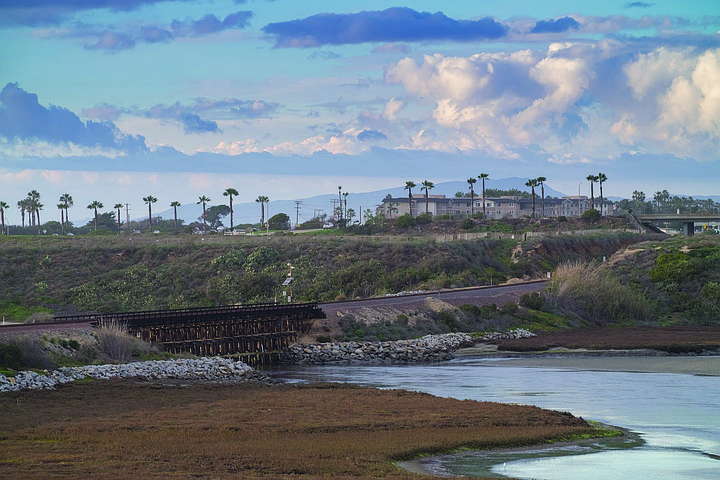
A few weeks later, I met a girlfriend at the trailhead for the Batiquitos Lagoon Ecological Reserve, off Gabbiano Lane in Carlsbad. My friend knew the trail well; had hiked it many times. But I once again brought along the pages from both books, both of which I read aloud before we started out. Again, Schad’s description was cursory. The massive dredging project in the 1990s that restored the lagoon’s health had only just been completed when my copy of Afoot and Afield (the third edition) was printed. In it Jerry declared that it remained to be seen if the restoration could be sustained. The scene that greeted my friend and me made it clear that question has been settled. We watched an osprey hunt, soaring over the teeming lagoon water, along with many other seabirds. Had we looked for them, we probably could have found the California desert thorn (Lycium californicum) or chalk dudleya (Dudleya pulvurulenta) that are pictured next to the Canyoneers’ description of the hike. But we were too busy chatting. We did stop to marvel at all the shell bits embedded in the lagoon banks. Whereas Jerry notes that these are the remains of the shellfish gathered and consumed by native Americans “prior to two centuries ago,” I felt more impressed by Coast to Cactus’s confident assertion that those seafood feasts went on “for 9000 years.”
On yet another recent Sunday morning, I wanted to take along Jerry’s description of another coastal hike I’d selected from Coast to Cactus. But the easy two-mile tour along the edge of Famosa Slough in Loma Portal wasn’t in my copy of the older trail guide.
Maybe because it wasn’t, I’d never hiked there, even though Famosa Slough is less than 20 minutes from my house. I have a friend who, decades ago, worked passionately to protect the slough from development. Yet somehow, I’d missed getting out to it. I used Coast to Cactus’s GPS coordinates to reach the trailhead. Then I took off through the mix of salt marsh and coastal sage scrub. It was a warm bright morning, and the pond water reflected the powder-blue sky like an antique mirror. Scores of ducks and coots paddled by, but what caught my eye were the elegant large white birds wading and fishing. The Canyoneers’ description told me this was a white great egret (Ardea alba), and that it nests in high trees and is the symbol of the National Audubon Society. If I knew that before, I’d forgotten it. That morning, I was happy to be reminded.


Since Afoot and Afield in San Diego County first appeared in 1986, Jerry Schad’s comprehensive guide to local hiking trails has been considered the definitive resource. But Schad’s death from liver cancer in 2011 sent the venerable hiking guide into limbo. Although a fifth edition prepared by local hiking enthusiast Scott Turner finally is scheduled for publication in February, it now faces serious competition. Coast to Cactus: The Canyoneer Trail Guide to San Diego Outdoors, released in September, 2016, is almost 600 pages long and weighs more than two and a half pounds. It contains descriptions of 245 outings (and 73 optional extension hikes) prepared by one of the best-respected hiking organizations in the county. Will it reign instead as the local hiking Bible?

Diana Lindsay is not the most objective observer, but I asked her if the two books are competitors. Along with her husband Lowell, Lindsay cofounded the company that published Coast to Cactus. She served as the book’s managing editor and was one of its key champions. She downplays any overt competition with Schad’s work, instead arguing that the two books have different missions.
They also developed differently, though both have deep local roots. The Lindsays met as Bruin Mountaineers back in the early 1960s, when she was a UCLA freshman and he was a senior and president of the campus hiking club. “We went spelunking together at Church Cave in the Sequoias,” Diana recalls. When Lowell was accepted for Navy flight school in the fall of 1964, they impulsively eloped. “We’ve been hiking forever. It’s in our blood.”

After flight school, her husband was assigned to duty as a helicopter pilot based in San Diego. Diana finished her undergraduate degree at San Diego State, and in their spare time, the couple began exploring the Anza-Borrego desert, glimpses of which had intrigued Lowell during his training flights out to Yuma. Diana also began using the desert as a topic for term papers; by the time she graduated, she’d written enough of them that a professor suggested she could easily combine them into a master’s thesis. She eventually did that, and a turn of good fortune brought her work to a larger audience. One of the professors on her thesis committee, Abraham Nasatir, was an authority on Southwest history and good friends with Richard Pourade, the editor of Copley Books. The publishing arm of the local newspaper had just released a history about Anza the explorer and wanted to publish something about the park named after him. Nasatir told Pourade about Lindsay’s work, “and the next thing, in the mail comes a contract offering to publish my master thesis,” she recalls.
Although the Lindsays left San Diego when Lowell took a job with the YMCA in Orange County, Diana says the two of them continued to hike in the Anza-Borrego desert, all the while taking notes and recording the mileage they covered. A guidebook for the desert existed but it had not been revised in years, and its elderly author was ill. Diana says she urged the park rangers to write a new one, but they weren’t interested. So she and Lowell finally decided to create one on their own. Their Anza Borrego Desert Region was published in 1978 by the Wilderness Press, but when the Lindsays moved back to San Diego in 1980, Diana wasn’t happy with the way either of her books was being marketed. That dissatisfaction led to her getting jobs in publishing and finally launching Sunbelt Publications in 1984.

Diana says it was sometime after she and Lowell wrote their desert guidebook that they first met Schad in a writing group. A shy young astronomer with a pronounced stutter and a passion for the natural world, he had a vision for creating a county-wide guide to the varied hiking opportunities here. He got a start on the research while writing a series of articles for San Diego Home/Garden magazine, and later, the San Diego edition of the Los Angeles Times. Wilderness Press wound up publishing the first collection of his outing descriptions in 1986. In 1992, Schad started a new column, “Roam-O-Rama,” which began appearing weekly in the San Diego Reader and provided material for his later editions of the hiking handbook.
Diana Lindsay says over the years she expressed interest in Sunbelt’s acquiring Schad’s Afoot and Afield from Wilderness Press, but the other publisher never wanted to relinquish it. (She never succeeded at getting the publishing rights to her own Anza Borrego Desert Region back from Wilderness, which will soon be issuing a sixth edition of it.) Sunbelt did release a guide to cycling in San Diego written by Schad. But by 2001, Lindsay had developed a vision for a different kind of book to accompany locals hitting the trails.

She says it was inspired by what she’d learned in the Canyoneers group at the San Diego Natural History Museum. That group had been started back in the 1970s by a museum botanist named Helen Chamlee, who wanted to introduce more members of the general public to hiking. Chamlee designed classes to train volunteers to lead nature walks in Florida Canyon, just east of the museum. “You had to take an eight-week course and then lead public hikes for two years,” Diana says. She and Lowell had grown increasingly curious about and interested in the plants, animals, and geology of the areas they were exploring in the desert, so around 1988, they took the classes and joined the cadre of Canyoneer volunteers. By then the group had expanded beyond Florida Canyon and was offering hikes countywide. Diana says she and Lowell suggested a number of desert destinations for inclusion in the regular outings.

The two of them were troubled, however, by the fact that inquisitive hikers had to take along so many books — trail guides, bird guides, plant guides, mineral references — in order to understand what they were seeing. “We kept saying, ‘Wouldn’t it be great to have one book that combined everything?’” The Canyoneers for years had been keeping notes about the natural features of all the hikes led by its volunteers. Diana says in 2001 she finally suggested to two Canyoneer leaders, Alan Marshall and Paula Knoll, that the organization should create its own combination trail-and-field guide, using all the material amassed over the years. Marshall and Knoll were enthusiastic. But when the trio went before the whole organization in early January 2002, the idea “went over like a lead balloon.” The other members thought it was overwhelming, Diana says. “They were all volunteers, and it was too massive a job.”
In the years that followed, Lindsay and Marshall periodically tried to resuscitate the idea. “But it never got anywhere,” Diana says.
Then Schad died. His passage rocked all those who knew him or were fans of his writing. His discovery in 2010 that he had end-stage kidney cancer was made even crueler by the fact that he had just met Peg Reiter, who appeared to be his soul mate. The two married, but they had all too little time together before Schad succumbed to his illness at 61.
On October 4, 2011, a group gathered at the patio of the El Cortez Hotel for a memorial service. Diana was among them. She says before Schad died he had talked to a longtime friend, Don Endicott, about taking over revisions of Afoot and Afield, and Wilderness Press wanted Endicott to do it. But the size of the task daunted Endicott. Diana says, at the service, San Diego Reader publisher Jim Holman “stood up and said some very nice things about Jerry. Then he mentioned that they had enough columns to get through to the end of the year, but they needed someone to take it over. He said if anyone was interested, they should call.”
Diana felt electrified by the opportunity. She, Marshall, and Knoll once again presented the idea of a Canyoneer-created hiking-and-field guide, but with a new twist: the task of writing the entries could be spread over the group’s more than 60 members, over years, if necessary, with each member signing up for one column at a time and taking months to write his or her column, if necessary. “All along, the intent was to get enough of these columns to put a book together,” Diana says. With the column format providing structure and motivation, the task suddenly seemed manageable.
Another part of Diana’s pitch was that all the royalties from the book would go to the museum to help support its activities. The Canyoneers traditionally had raised a couple of thousand dollars each year by collecting and selling mistletoe during the holiday season, but a big new book could significantly boost that contribution, her argument went. Persuaded by it, the Canyoneers and the museum signed a memorandum of understanding with Sunbelt.
The first Canyoneer-written “Roam-O-Rama” column appeared in January 2012. “We started by taking all the Canyoneer hikes that we had already done and asking people to sign up to write about them.” At that point, the group had developed probably 75 to 100 outings throughout the county, Diana estimates. She says, “We also looked at Jerry’s book to see what he had done. It was old [2007] and hadn’t been revised as fires had occurred. So we had to see if the hikes in his book were still good or bad. Also, the county and the people at California State Parks had developed new hikes.” The Canyoneers sought input from them and other organizations. “Any of their suggestions that were not already Canyoneer hikes were put on our list, and then we asked Canyoneers to go out and scope them out.”
“We ended up finding a lot of hikes that Jerry didn’t have,” Diana says. “And there were hikes that he had but we didn’t include because times had changed; there were fires, or the rules and regulations had changed, or something. Also, we decided not to include most of his hikes that were outside the county.”
Even so, by 2015, 260 hikes had been written up by Canyoneers and edited by Diana, Knoll, and a Canyoneer named Terri Varnell. (Sadly, Marshall passed away before the new book could be completed.) That number was eventually reduced to 245.
“We were already 100 pages over Jerry’s book [which had grown over the years to include 250 hikes] because we added so much about the species. All that additional information just made it a lot larger. My staff was yelling at me. Everybody was yelling at me. We had to just stop!”
In some ways, the entries in Coast to Cactus immediately recall those in Schad’s book. All begin with brief summaries of the distance, difficulty, elevation gain and/or loss, estimated hiking time, optional maps, and other information (some of it new, such as trailhead GPS coordinates). Some differences are just as obvious: full-color printing of the new book, for example. Or the strong, consistent emphasis on the nine main habitats found in San Diego County (grassland, chaparral, riparian, et cetera) — several of which may be found on any given hike.
Diana says Coast to Cactus users may notice a difference in the standard for grading the difficulty of hikes. “The thing is, Jerry was a super-athlete — an ultramarathoner and a bike rider and more. So if someone who was not used to hiking went on what he called a medium hike, it might take them a lot longer and be more strenuous than what they were prepared for.” Accustomed to taking out the general public, the Canyoneers felt compelled to gear that standard down. “We don’t want people getting into trouble. So our grading system is based on 1) distance, 2) elevation, and 3) what the terrain is like. We might call a five-mile hike with some elevation gain ‘strenuous.’”
A far more profound difference between the two books is that Coast to Cactus was always intended to be a comprehensive field guide. Diana stresses the way it complements the new permanent exhibition at the Natural History Museum (“Coast to Cactus Southern California”). The exhibition focuses on the diversity of life found within San Diego County, much of which falls within the so-called California Floristic Province. That region ranks among 35 internationally recognized biodiversity “hotspots.” These are places that together cover less than 2 percent of the planet but are home to more than a third of the vertebrate animals and 44 percent of the vascular plants — and are threatened because of disappearing habitat.
Diana says while Afoot and Afield was long the premier hiking guide in the county, it made no attempt to consistently explain how the habitats in which each hike was situated fit into this larger picture. “It was: you go five miles, you come back, and you did it! Scratch it off; you did that hike.” If the hiker was asked what he saw, he might respond, “I don’t know. I went up and down. It was great.’”
In contrast, Diana says the Canyoneers “want people to come back from their hike and have learned something.” The color photos, the comprehensive index, the table of common and scientific plant and animal names all are intended to foster the learning process. “We intend for people to not be racing to finish a hike, but to be slow. To look around. To listen. To smell. And figure out: what is in this habitat. Why is it a hot spot? We want everybody to finish their hike and say, ‘Wow, I didn’t know that.’ If you learn to appreciate these things, you start to love them, and you will be more inclined to protect them.”
I’ve done a couple of the Coast to Cactus hikes so far, and I’ve been struck by the strong instructional tone. It’s not that Schad never mentioned the names of plants or animals in his guidebooks or columns. He did so frequently. But on my countless Schad-inspired outings, that information felt secondary to the main point of getting out and striding along a trail. The pleasures Schad had felt in hiking each path felt palpable and personal, and I appreciated how his written words allowed me to follow in his footsteps and experience the same satisfactions.
When my husband and dog and I headed out one September morning, we took copies of the pages from both guidebooks describing the trails at the Torrey Pines reserve extension. The extension occupies some undeveloped land north of Carmel Valley Road, across from the famous and popular (main) part of the state reserve on the south side of Peñaquitos Lagoon. For all the times we’ve hiked at the main reserve, we’d never made it to the extension. Jerry’s description was minimal, four brief paragraphs in which he noted that the “narrow, less-maintained pathways offer a sense of peacefulness and isolation you can’t get along the main reserve’s well-beaten trails.”
The pages from Coast to Cactus included much more information: detailed paragraphs about some of the key coastal sage scrub plants, as well as color photographs of two of them (white sage and coastal sagebrush). But what seemed invaluable to us was the little map of the trails. Signage in the extension is minimal, and we needed the diagram to figure out where we wanted to go.

A few weeks later, I met a girlfriend at the trailhead for the Batiquitos Lagoon Ecological Reserve, off Gabbiano Lane in Carlsbad. My friend knew the trail well; had hiked it many times. But I once again brought along the pages from both books, both of which I read aloud before we started out. Again, Schad’s description was cursory. The massive dredging project in the 1990s that restored the lagoon’s health had only just been completed when my copy of Afoot and Afield (the third edition) was printed. In it Jerry declared that it remained to be seen if the restoration could be sustained. The scene that greeted my friend and me made it clear that question has been settled. We watched an osprey hunt, soaring over the teeming lagoon water, along with many other seabirds. Had we looked for them, we probably could have found the California desert thorn (Lycium californicum) or chalk dudleya (Dudleya pulvurulenta) that are pictured next to the Canyoneers’ description of the hike. But we were too busy chatting. We did stop to marvel at all the shell bits embedded in the lagoon banks. Whereas Jerry notes that these are the remains of the shellfish gathered and consumed by native Americans “prior to two centuries ago,” I felt more impressed by Coast to Cactus’s confident assertion that those seafood feasts went on “for 9000 years.”
On yet another recent Sunday morning, I wanted to take along Jerry’s description of another coastal hike I’d selected from Coast to Cactus. But the easy two-mile tour along the edge of Famosa Slough in Loma Portal wasn’t in my copy of the older trail guide.
Maybe because it wasn’t, I’d never hiked there, even though Famosa Slough is less than 20 minutes from my house. I have a friend who, decades ago, worked passionately to protect the slough from development. Yet somehow, I’d missed getting out to it. I used Coast to Cactus’s GPS coordinates to reach the trailhead. Then I took off through the mix of salt marsh and coastal sage scrub. It was a warm bright morning, and the pond water reflected the powder-blue sky like an antique mirror. Scores of ducks and coots paddled by, but what caught my eye were the elegant large white birds wading and fishing. The Canyoneers’ description told me this was a white great egret (Ardea alba), and that it nests in high trees and is the symbol of the National Audubon Society. If I knew that before, I’d forgotten it. That morning, I was happy to be reminded.
Comments